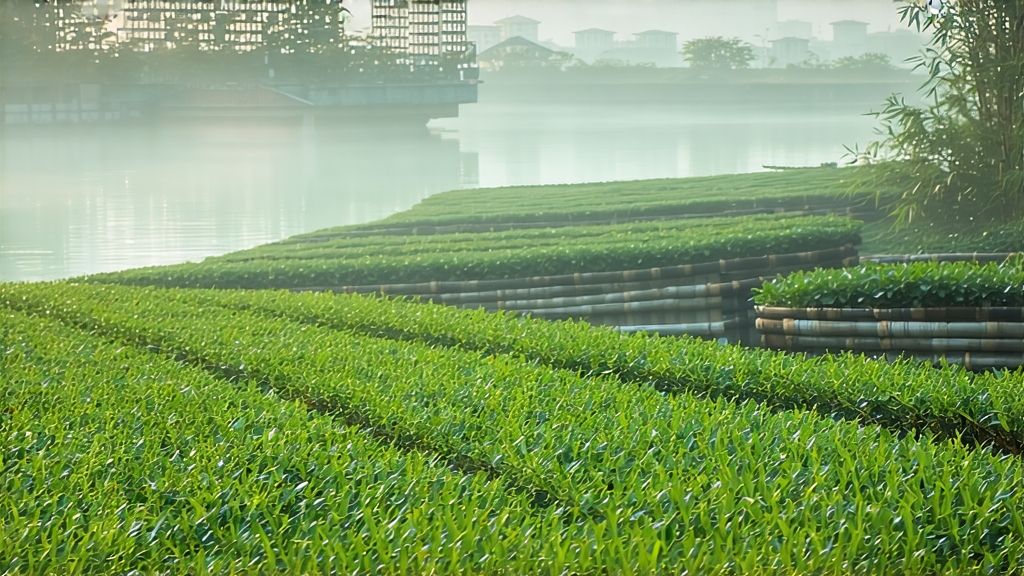
Longjing—often spelled Lung Ching outside China—is more than a beverage; it is a liquid manuscript of Chinese civilization. When the first spring breeze skims the surface of West Lake in Hangzhou, the hills of Shi-feng, Mei-jia-wu, Weng-jia-shan, and Hu-pao tremble awake, and the 18 imperial tea bushes donated by the Qianlong Emperor in the eighteenth century once again become the most photographed plants on earth. From that moment until Grain Rain, every dawn is a race between fog and sun, between leaf and hand, between tradition and the impatient modern world.
History: From Imperial Tribute to Global Icon
Although green tea was recorded in Tang dynasty treatises (618-907 CE), Longjing enters documented history in the Song, when the Buddhist monks of Tian-zhu and Ling-yin temples shaded their terraces with bamboo to cool the leaf. The Ming scholar Tian Yi-heng wrote in 1555 that “the spring on Tiger-Running Hill perfumes the tea so that one cup clears the palace of the mind,” fixing the marriage of Longjing and its terroir in literature. The Kangxi Emperor’s 1689 southern tour first brought court attention; his grandson Qianlong, during the 1751 visit, famously pocketed a handful of shoots after watching maidens sing while plucking, then decreed that the 18 bushes beside Lion Peak should be reserved for the dowager empress. By the late Qing, Longjing had become hard currency in diplomatic gifts, arriving in London and Saint Petersburg inside silk-lined tins. The 1915 Panama-Pacific International Exposition awarded it a Grand Prize, sealing its global reputation. Today the 800-hectare core zone is a UNESCO World Heritage buffer, and the earliest 60 kg of Ming-qian (pre-Qingming) Shi-feng Longjing sells at auction for more than the price of gold per gram.
Terroir: Why the Lake Makes the Leaf
West Lake is a drowned river valley oriented east-west; morning humidity rises, meets cool air sliding down the northern Tian-mu range, and forms a 200-meter cloud belt that acts like a natural shade-cloth. This slows photosynthesis, increasing amino acids—especially L-theanine—while the quartz-rich sandstone subsoil drains quickly, forcing roots to dive deep for minerals. The result is a singular balance: sweetness without grassiness, fragrance that hovers between fava bean and toasted brazil nut, and a lanolin texture the Chinese describe as “tofu skin.” Within the protected region, Shi-feng (Lion Peak) gives the most mineral bite; Mei-jia-wu the roundest body; Weng-jia-shan the orchid nose; Hu-pao (Tiger-Running) the longest aftertaste. Any leaf grown outside these four townships—even if the same cultivar and technique are used—may be labeled Zhe-jiang Longjing but never West Lake Longjing, a geographic indication policed as fiercely as Champagne in France.
Cultivars: The Green Gene Pool
The original land-race is the Old-Species Longjing (#43 before modern breeding). It emerges early, bears a characteristic “sparrow’s tongue” shape, and carries the highest concentration of dimethyl sulfides that create the nutty aroma. In 1979 the Tea Research Institute released Longjing #43, a clonal selection prized for winter hardiness and uniform budding, now 70 % of plantings. More recent trials include Zhong-te #108 (floral) and Bai-ye #1 (albino, pale jade), yet purists still pay triple for old-tree leaf picked from seed-grown bushes hidden in the ravines behind Yong-fu temple.
Craft: The 10 Hand-Moves That Stop Time
Longjing is the only famous Chinese green tea still shaped entirely in a hot wok without mechanical compression. A master with 30 years’ experience works at 180 °C barefoot to feel the wok temperature through bamboo slippers. The choreography—captured in 1958 government training films—has ten named motions: grasp, shake, rub, throw, fan, press, push, grind, buckle, and clasp. Within 100 seconds the leaf must lose 30 % moisture yet retain the spring green that the Chinese call “alive.” The critical “hui-guo” (return-to-wok) step occurs after initial shaping; temperature drops to 80 °C for 20 minutes, driving off the last